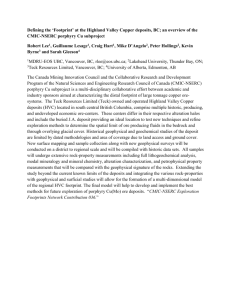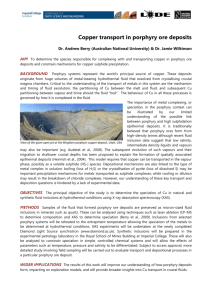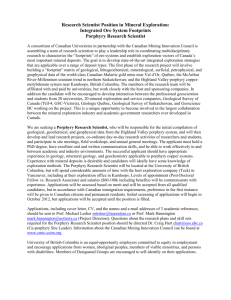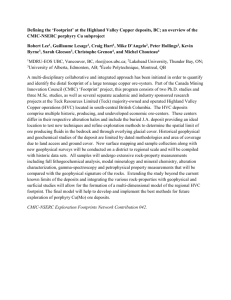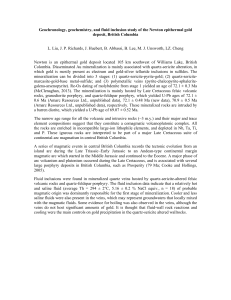Presentation
advertisement
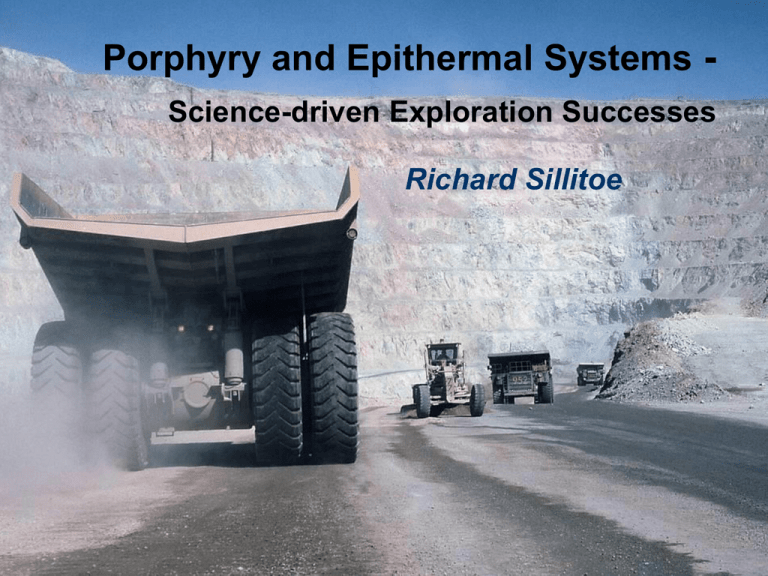
Porphyry and Epithermal Systems Science-driven Exploration Successes Richard Sillitoe Porphyry and epithermal deposits Porphyry copper-molybdenum and copper-gold deposits are centred on shallow-level porphyry intrusions Grasberg, Indonesia Epithermal gold and silver deposits are typically hosted by volcanic rocks Round Mountain, Nevada 2 Porphyry and epithermal systems – the state of play at end of 1960s (1) • Epithermal-hot spring linkage proposed (D.White), but relationship uncertain • Types of epithermal deposits not appreciated (forgetting F.L.Ransome and W.Lindgren) • Porphyry-epithermal connection unknown • Porphyry intrusion-volcano connection unknown • Plate tectonic setting and relationship of porphyry copper deposits to subduction unrecognised (plate tectonics in its infancy) 3 Porphyry and epithermal systems – the state of play at end of 1960s (2) • Ages of copper and gold belts and provinces poorly defined (isotopic dating in its infancy) • Zoning patterns of hydrothermal alteration in porphyry and epithermal deposits poorly appreciated • Porphyry gold and gold-rich porphyry copper deposits undefined (notwithstanding Panguna) • Bulk-tonnage epithermal gold deposits undefined (reflecting low gold price) 4 The favourite buzz words for today’s press releases on porphyry and epithermal projects HOT-SPRING SINTER STEAM-HEATED ENVIRONMENT PALEO-WATER TABLE HIGH-SULPHIDATION SYSTEM VUGGY QUARTZ LOW-SULPHIDATION SYSTEM POTASSIC ALTERATION DIATREME-HOSTED HYPOGENE COPPER ENRICHMENT ADVANCED ARGILLIC LITHOCAP Unknown to the exploration community at the end of 1960s Active hot-spring sinter terrace, Champagne Pool, New Zealand 5 Porphyry-epithermal relationships Linkages between porphyry, high- and intermediatesulphidation epithermal, skarn, carbonate-replacement, and Carlin-like environments now widely appreciated The necessary information was supplied by worldwide exploration activities 6 High-sulphidation - porphyry transition • 1.5 – 2 km vertical interval represented from paleo-surface to porphyry deposit • Vuggy quartz → quartz-alunite → quartz-pyrophyllite → quartz-sericite from top downwards • Au-dominated → Cu-dominated from top downwards 7 Shallow epithermal features • High- and intermediate sulphidation deposits with andesitic-dacitic arc volcanism • Low-sulphidation deposits with compositionally bimodal (basaltrhyolite) volcanism in extensional (rift) settings • Steam-heated environment, hot-spring sinter and paleowater table silicification recognised above Au-Ag mineralization - Again exploration supplied the data 8 Deposit-scale features Alteration zoning — recognising importance of potassic alteration for copper introduction in porphyry copper deposits Los Pelambres, Chile Discovered 1969, United Nations 3,300 Mt @ 0.63% Cu, 0.016% Mo Bajo de la Alumbrera, Argentina Discovered 1971, United Nations 700 Mt @ 0.51% Cu, 0.66 g/t Au Potassic alteration (beneath weathering zone) Potassic alteration (weathered at surface) 9 Deposit-scale features Alteration zoning — recognising significance of alteration types in high-, intermediate- and low-sulphidation epithermal systems La Coipa HS deposit, Chile Discovered 1983, Amax 8.46 Moz Au Eq Vuggy quartz in discovery outcrop: residue after leaching by highly acidic fluid Pascua-Lama HS deposit, Chile-Argentina Discovered 1989, Lac Minerals, then Barrick Gold Barren steam-heated alteration above 16 Moz gold and >600 Moz silver 10 Tops of porphyry copper deposits Guinaoang porphyry copper-gold system, Philippines Discovered 1983, RGC Exploration >500 Mt @ 0.4% Cu, 0.4 g/t Au Deposit concealed beneath advanced argillic lithocap containing highsulphidation mineralization 11 Tops of low- and intermediate-sulphidation epithermal deposits El Peñón, Chile Blind vein discoveries 1998-2007, Meridian Gold 8.4 Mt @ 14 g/t Au, 234 g/t Ag Fence drilling to intersect predicted favourable stratigraphic interval Quebrada Colorada Esquel, Argentina Discovered 2000, Minera El Desquite (Brancote) 3.8 Moz Au, 7 Moz Ag Recognition that two-thirds of deposit is concealed beneath pre-mineral cover Fruta del Norte, Ecuador Discovered 2006, Aurelian 13.7 Moz Au, 22.4 Moz Ag Drilling deep beneath a linear silicified zone containing anomalous arsenic and antimony 12 Recognition of new mineralization styles Montana Tunnels, Montana, USA Discovered 1983, Centennial Minerals 61 mt @ 0.96 g/t Au, 12 g/t Ag, 0.67% Zn, 0.28% Pb Disseminated mineralization in phreatomagmatic diatreme breccia Marte porphyry gold deposit, Chile Discovered 1982, Anglo American-Cominco j.v. Soon led to discovery of nearby Lobo porphyry gold deposit by same j.v. Combined: 5.5 Moz Au Wafi, Papua new Guinea Discovered 1990, CRA Exploration Hypogene copper enrichment due to high-sulphidation copper sulphides at base of lithocap overprinting porphyry copper-gold deposit 13 District-scale porphyry copper alignments and clusters (“trendology”) Detailed geology and scout RC drilling beneath alluvial cover Chuquicamata district, Chile Orogen-parallel alignment New discoveries 2000-2006, Codelco Oyu Tolgoi district, Mongolia Arc-transverse alignment New discovery 2007, Ivanhoe Mines (supplied by I.Kavalieris) Deep IP survey – on trend • Comparable brownfield discoveries in Los Bronces alignment (Sulfatos, Anglo American) and Escondida cluster (Pampa Escondida, MEL), Chile 14 Definition of porphyry copper belts and epochs Isotopic dating has defined regional-scale belts and corresponding epochs in most porphyry copper provinces Isotopic dating now routine selection tool in Andean copper province and elsewhere Examples: • Gaby (Gabriela Mistral): 540Mt @ 0.52% Cu Ox – prioritised during initial exploration because of 43 Ma age • Other prospects – discarded because of 290-200 Ma ages 15 Definition of epithermal belts and provinces Regional-scale belts and provinces become focus of exploration for specific epithermal deposit type After Riley et al. (2001) After John et al. (2000) Examples: • Northern Nevada rift: 16-14 Ma • Patagonia: 160-150 Ma 16 Origin of metallogenic provinces Tectono-magmatic processes or predisposition? • Clustering of 10 Moz Au belts and isolated deposits of different types and ages • Suggestive of predisposition – metal preconcentration or other chemical parameter (e.g. redox state) • Focus exploration on endowed arc segments, but usually well explored (exception Colombian Andes) • Or define unrecognised gold-rich arc segments – but how? 17 Key role of geology in porphyry and epithermal exploration 68 6 16 4 2 2 4 5 6 1 3 6 24 14 66 47 31 23 30 36 46 9 13 19 22 29 35 39 45 50 53 8 12 18 21 26 28 34 38 42 44 49 52 55 65 59 64 58 61 63 70 72 7 10 11 17 20 25 27 32 33 37 40 41 43 48 51 54 56 57 60 62 69 71 1970 Circum-Pacific Region 67 15 1980 74 1990 Discovery Year 2000 1990 2000 Geological work 4 2 1970 6 1980 Geochemistry 4 2 1970 6 1980 1990 2000 1980 1990 2000 1980 1990 2000 Geophysics 4 2 1970 6 4 77 79 73 75 76 78 Serendipity Drilling 80 81 Parameters • 37–year history • 81 deposits • Mainly porphyry, epithermal, & sediment-hosted gold (minor VMS & orogenic gold) Main conclusions • Notwithstanding exploration changes, little overall evolution in discovery methodology (but see next slide) • Geologic fieldwork: 90% of discoveries – routine observation, mapping, & interpretation – familiarity with deposit models (since 1980s) • Geochemistry: 70% of discoveries – stream sediment, soil, & rock chip • Geophysics: 15% of discoveries (only 50% of programs) – Ground IP & EM • Drilling & serendipity: 12% of discoveries • Remote sensing (satellite imagery, airborne scanners: 0%) 2 1970 18 The future of porphyry and epithermal exploration We need: • New geological concepts • Characterisation of distal manifestations of concealed and potentially deep orebodies • New technological break-throughs • Properly qualified and motivated personnel to do the job Rio Tinto, 2008 Last 40 years have brought great advances in the porphyry-epithermal environment; next 20 years must bring even greater advances if we are to satisfy growing demand for copper, gold and silver and societal expectations in general – all within increasingly stringent environmental and community constraints 19
